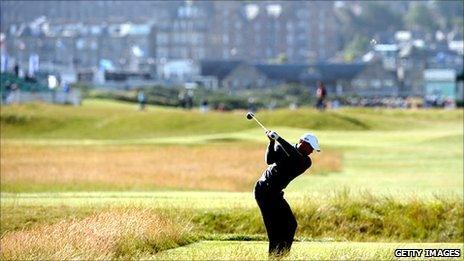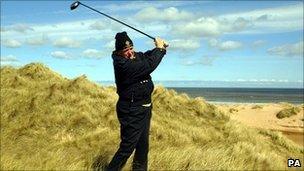Scottish golf brings business to the fore
- Published

Scotland fights to maintain its image as the home of golf
Golf is big business in Scotland. A recent report into its tourism potential reckoned the annual value to the nation's economy is £220m, and it supports about 7,000 jobs.
Further market research suggested that last year's 150th Open Championship at St Andrews was worth more than £100m to Scotland.
Just under half of that was in direct spend, while about £53m is the value of all that television and newspaper coverage into high-earning homes around the world.

There is a government plan to ensure every Scottish child has a chance to learn golf
The game is significant partly because Scotland is established as the home of golf, with some of the world's great courses attracting visitors - and they spend at twice the daily rate of the average tourist.
It's also that this is probably the only country in the world where golf is an affordable sport for everyone.
You can spend thousands per year on membership, or you can play a round for a reasonable fee at your local council-run course. Participation runs at roughly double the rate in England.
And with the Ryder Cup at Gleneagles in 2014, there's a government plan to ensure every Scottish child has a chance to learn.
Nearly half of the earnings classified as golf tourism in Scotland are from Scots touring their own country, with 70% from the UK as a whole. The biggest overseas market, the USA, accounts for 14% of the golf tourism market.
But the sport has hit hard times in the downturn. The golf club members who provide the main income to sustain more than 500 courses have been cutting back. Clubs are waiving joining fees, offering discounts and special offers, and they're having to get much sharper about the way they do business.
The clubs doing best are being hard-nosed about efficiency, and are no longer handing contracts to cronies and club members.
New courses
According to Gordon Simpson, general manager of Hilton Park golf club just outside Glasgow, they are also investing in youth development, with cadet and junior membership building up the next generation of members.
Some are still investing big money in the sport. Donald Trump is fronting up a bid to build "the world's best golf course" at the Menie Estate, north of Aberdeen. With a large hotel and housing attached to the development, its original price tag of £1bn has declined somewhat. Work is under way, while protests against the development persist.

Donald Trump at the beach where he plans to build a golf course at Menie Estate near Aberdeen
Castle Stuart, to the east of Inverness, has provoked less controversy with about £20m spent on developing it as a golf resort with luxury hotel. It's landed the Barclays Scottish Open this July, providing it with a marketing platform as it reaches into sports television around the world.
According to marketing director Fraser Cromarty, the new resort's approach is not to be exclusive, at a cost of thousands of pounds per year, but to treat everyone as if they were a valued club member for the day.
"Everybody's an equal," he said. "Everybody's our member for the day. They can hit as many range balls as they want, and sit where they want in the club house. There's no restrictions."
With trouble in keeping domestic spend, Lee Derrick, chairman of industry grouping Golf Tourism Scotland, says there are good prospects for growing business by attracting golfers from continental Europe, particularly from Germany and Scandanavia - and helped by low-fare flights.
In Europe's far north, he points out, snow cuts the golf season short, so year-round golfing in Scotland is an attraction.
Lateral thinking
But he says that relying on marketing Scotland as "the home of golf" runs the risk of complacency, when Ireland, Spain and Portugal can offer golf, often in more agreeable weather. That's one reason he sounds cautious about the suggested target of 30% growth of the market within this decade.
"If the clubs stand back and do nothing, there will be no growth," he says. "But we need to see (recognition) from a higher level, from government level, of the importance of golf tourism, (and) the support through funds to make growth happen."
Getting collaboration across the golf industry also requires thinking beyond the club house, to other areas where visitors spend. For every pound spent in green fees, it's reckoned £5 is spent elsewhere.
A business geared to that market is one of the few of remaining club-makers in Scotland, the St Andrews Golf Company. It's located just outside the university town that is golf's premier focus for pilgrimage.
Chief executive Ewan Glen says every town in east Fife had at least one small factory making clubs back in the 1950s, but it's thrown away much of that artisan skill. His company now makes bespoke modern clubs as well as vintage designs going back to the 17th Century.
While the corporate gift market has fallen apart in recent years, he is shifting marketing attention away from the USA to China and Taiwan. China already has 500 courses, and it's expected it will have more than 1,000 within eight years. For now, the tourism potential is largely focused on other parts of Asia.
Even though it is Far East manufacturing that has undercut much of Scotland's traditional club-making, Ewan Glen is selling to the Far East on the basis that it has cultures that value traditional, artisan skills.
Hear more about the business of Scottish golf, including how to network your business through golf, in a special edition of Business Scotland, on BBC Radio Scotland, 1005 BST, Sunday 3 April. Also available on BBC iplayer and by podcast.